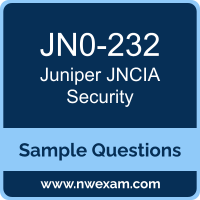01. Which operating systems are supported for Juniper Secure Connect?
(Choose two.)
a) Linux
b) Windows 7
c) Windows 10
d) MacOS
02. What is the correct order of processing when configuring NAT rules and security policies?
a) static NAT -> destination NAT -> policy lookup -> source NAT
b) source NAT -> static NAT -> destination NAT -> policy lookup
c) destination NAT -> policy lookup -> source NAT -> static NAT
d) policy lookup -> source NAT -> static NAT -> destination NAT
03. Which two statements about NAT are correct?
(Choose two.)
a) When multiple NAT rules have overlapping match conditions, the most specific rule is chosen.
b) Source NAT translates the source IP address of a packet.
c) Source NAT translates the source port and destination IP address.
d) When multiple NAT rules have overlapping match conditions, the rule listed first is chosen.
04. When configuring antispam, where do you apply any local lists that are configured?
a) custom objects
b) advanced security policy
c) antispam feature-profile
d) antispam UTM policy
05. You want to integrate an SRX Series device with Juniper ATP Cloud. What is the first action to accomplish this task?
a) Issue the commit script to register the SRX Series device.
b) Create an account with the Juniper ATP Cloud Web UI.
c) Copy the operational script from the Juniper ATP Cloud Web Ul.
d) Create the SSL VPN tunnel between the SRX Series device and Juniper ATP Cloud.
06. Which two statements are true about Juniper ATP e-mail protection?
(Choose two.)
a) Juniper ATP Cloud e-mail protection inspects SMTP traffic.
b) Juniper ATP Cloud e-mail protection inspects MAPI traffic.
c) Juniper ATP Cloud e-mail protection inspects IMAP traffic.
d) Juniper ATP Cloud e-mail protection inspects POP3 traffic.
07. Your company uses SRX Series devices to secure the edge of the network. You are asked to protect the company from ransomware attacks. Which solution will satisfy this requirement?
a) screens
b) unified security policies
c) AppSecure
d) Juniper ATP Cloud
08. Which two statements are true about security policy actions?
(Choose two.)
a) The deny action drops the traffic and sends a message to the source device.
b) The deny action silently drops the traffic.
c) The reject action drops the traffic and sends a message to the source device.
d) The reject action silently drops the traffic.
09. By default, revenue interfaces are placed into which system-defined security zone on an SRX Series device?
a) trust
b) null
c) untrust
d) junos-trust
10. A new SRX Series device has been delivered to your location. The device has the factory-default configuration loaded. You have powered on the device and connected to the console port.
What would you use to log into the device to begin the initial configuration?
a) admin with no password
b) root with a password of "juniper"
c) root with no password
d) admin with a password of "juniper"
 Before you write the Juniper JNCIA Security (JN0-232) certification exam, you may have certain doubts in your mind regarding the pattern of the test, the types of questions asked in it, the difficulty level of the questions and time required to complete the questions. These Juniper Networks Certified Associate Security (JNCIA-SEC) sample questions and demo exam help you in removing these doubts and prepare you to take the test.
Before you write the Juniper JNCIA Security (JN0-232) certification exam, you may have certain doubts in your mind regarding the pattern of the test, the types of questions asked in it, the difficulty level of the questions and time required to complete the questions. These Juniper Networks Certified Associate Security (JNCIA-SEC) sample questions and demo exam help you in removing these doubts and prepare you to take the test.